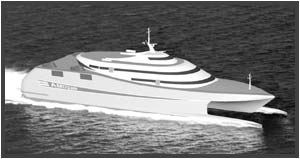Intercontinental Ferry
The Intercontinental Ferry is a ferry service that links the South-East Heartland continents of Probitas and Nous. The service operates across Temperance Sound between Sant Iago in Laudo Deo and The Red City in the independent Spaamanian territory of (Spaamanian) Plijous. Departing from both cities three times daily, 365 days per year, it offers a cheap, though timely, alternative to flying between the two contintents.
History
For many hundreds of years, there has been trade and commuting between Laudo Deo and Plijous via sea, with Sant Iago and The Red City being the most natural destinations. Of course, before the advent of the engine, the trip could easily take 4 days, even in good weather, and it was not unknown for ships to be blown off course, or even sunk, as the area has been known to suffer tropical hurricanes. However, humans (and other races) were not to be deterred, and the crossing eventually became safer and faster. With the advent of steam in the mid-1800s, the crossing could be done in around 30 hours, and by the beginning of the 20th century, some ships were taking just 16 hours. The Intercontinental Ferry service was first established in 2006, and operated once daily, from each city, five times per week. Two ferries were in service, taking around 500 passengers each, and making the crossing in around 10 hours. It was still rather costly, and flight was much cheaper per hour, but it catered to the less affluent populace who had time to spare.
Route
The route is approximately 420 nautical miles (780 kilometres), taking an almost straight path across Temperance Sound between The Red City International Port and Sant Iago harbour. Travelling at an average speed of 70 knots (130 kilometres per hour), the trip is usually accomplished in under 7 hours, though delays of up to a couple of hours due to bad weather is not unheard of.
Ferries
In 2106, the hundredth anniversary of the Intercontinental Ferry, six new ferries were announced to gradually replace the entire fleet, some of which had been operating for over thirty years. Built by Spaamanian company Austral Maritime, the AM70 can take up to 1500 passengers: 400 first class, and 1100 economy class. They are powered by four hydrogen gas turbines, and has a top speed of 75 knots (140 kilometres per hour) under full load, able to make the crossing in under 7 hours. On each of the ferries there is a food court, convenience store, as well as the usual general amenities. The six ferries' names are: Choi, Fania, Gonzales, Pasierbek, Shaw, and Wielunska.
Timetable
The timetable for the ferries is usually fixed, but there are occasionally changes when each of the ferries goes through its yearly service, or if there are any mechanical failures. There are three services daily, the same in both cities (local time): Morning (9am - 4pm), Afternoon (12pm - 7pm), and Night (11pm - 6am).
| Sant Iago (Laudo Deo) | The Red City (Plijous) | |||||
|---|---|---|---|---|---|---|
| Morning | Afternoon | Night | Morning | Afternoon | Night | |
| Monday | Wielunska | Choi | Pasierbek | Fania | Shaw | Gonzales |
| Tuesday | Fania | Shaw | Gonzales | Wielunska | Choi | Pasierbek |
| Wednesday | Wielunska | Choi | Pasierbek | Fania | Shaw | Wielunska |
| Thursday | Fania | Shaw | Wielunska | Choi | Pasierbek | Fania |
| Friday | Choi | Pasierbek | Fania | Gonzales | Wielunska | Choi |
| Saturday | Gonzales | Wielunska | Choi | Pasierbek | Shaw | Gonzales |
| Sunday | Pasierbek | Shaw | Gonzales | Wielunska | Choi | Pasierbek |
Cost
The ticket price has been constant in Spaamanian currency since 2106, though Laudo Deian currency fluxuates a lot. The price for an economy ticket is L50 laari (about $100) for an adult, and L100 laari for first class, with children under six full years travelling for half price. In Laudo Deo, the price is currently (2125) F2150 Fen for an economy ticket, and F4300 Fen for first class.
External Links
Intercontinental Ferry (Spaam site)
Intercontinental Ferry (Laudo Deo site)


